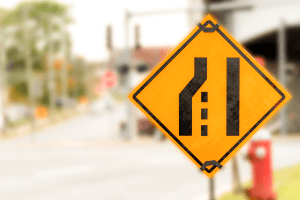Factors that Help Determine Liability for a Merge Lane Accident in California
 Merging onto the freeway or out of a lane that is ending can be tricky, and accidents can occur when drivers are not careful. Determining who is at fault for a merging collision can be more complicated than you might think.
Merging onto the freeway or out of a lane that is ending can be tricky, and accidents can occur when drivers are not careful. Determining who is at fault for a merging collision can be more complicated than you might think.
If you were injured in a merging crash and believe it is the other driver’s fault, our Sacramento car accident lawyers may be able to help you pursue the compensation you need for medical bills and other damages related to the crash.
Below, we discuss what factors may be considered when determining liability for a merge lane accident.
WHICH DRIVER HAS THE RIGHT OF WAY?
The primary factor in a merge lane accident is who had the right of way when the accident occurred.
MERGING ONTO THE FREEWAY
California law specifies that freeway traffic has the right of way, so a driver who is attempting to merge onto the freeway must take certain precautions to avoid an accident and risk being held liable for any damages that may result.
According to the California Driver Handbook, drivers must enter the freeway at or near the speed of traffic and should not stop before merging into traffic unless it is absolutely necessary. Drivers are also discouraged from trying to merge into small gaps to avoid following too closely. They are encouraged to use their mirrors, turn signals and check their blind spots to ensure the lane they are attempting to merge into is clear.
MERGING OUT OF A CLOSED LANE
While state law on merging onto the freeway is clear about the right of way, California does not have a clear-cut policy on who has the right of way when drivers are required to merge into another lane because the current lane is ending. If a driver sees a lane is closing, do they have the right of way to merge into another lane due to the closure? Or, is the other driver required to yield?
There is a general consensus from the California Highway Patrol that the situation dictates when drivers should merge and who has the right of way if a lane is closing. In situations when the lane is ending but traffic has not slowed down, officials say it would be best for drivers to stay in their lane until the last second and merge using an alternating “zipper” method. If traffic has slowed down, officials encourage drivers to merge earlier than the end of the line.
IMPROPER MERGING
Drivers who fail to merge properly could be held liable for an accident. Some of the most common forms of improper merging include:
- Not signaling
- Cutting off other drivers
- Crossing multiple lanes of traffic
- Not checking blind spots
- Merging at a high/slow speed
- Not leaving enough space between cars
While proving improper merging may be difficult, a police report, witness statement or accident reconstruction report could help prove that another driver acted negligently while merging and therefore caused the crash that hurt you.
TIPS TO AVOID MERGE ACCIDENTS
For your safety and the safety of others on the roadway, signal when attempting to merge and check your blind spot to ensure no other vehicle is in the lane you are trying to move into.
Remember to ease smoothly into the lane. If you need to cross multiple lanes, allow time to do so one lane at a time to avoid cutting off other drivers who may be traveling at a higher speed.
HURT IN A MERGING ACCIDENT? CALL US TODAY
If you were injured in a merge lane accident, contact a licensed attorney to help determine which driver was negligent in that particular situation and caused the collision.
Our attorneys have experience handling a variety of car accident claims and have secured millions in compensation on behalf of our clients.
The Arnold Law Firm works on a contingency basis, meaning there are no fees unless you get paid, so there is no risk to speak to an attorney. During your free consultation, our attorneys will evaluate how we may be able to help you. There is no obligation to pursue legal action.
No fees. No obligation. Call us today at (916) 777-7777
